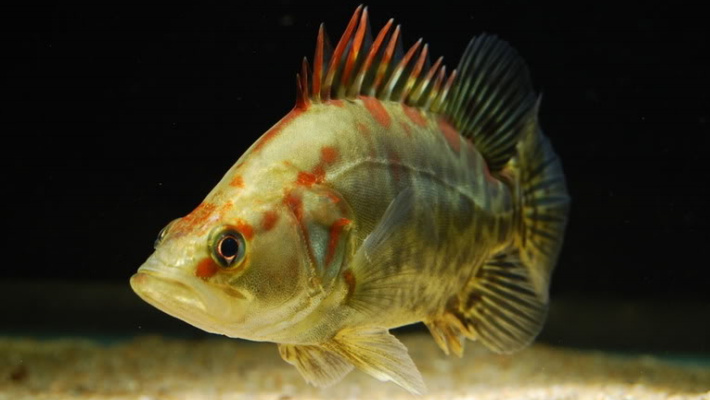|
Conspicuous coloration of males occurs
in many species of fish, birds and other animals being advantageous in
attracting potential mates. Although bright colors can entice females of the
same species, these colors may also attract predators. Female choice for bright
males and an enhanced risk of predation for bright males are both well
documented in numerous works (see Dill et al., 1999, and references therein).
Because
fresh waters are optically turbid in comparison with pure sea waters, curves of
photopic spectral sensitivity in freshwater fish are strongly displaced to the
red part of the spectrum. For example, the maximum of spectral sensitivity in
threespined stickleback, Gasterosteus
aculeatus, is near 605 nm (Rowe et al., 2004). It means that for eyes of freshwater fish red and orange colors are brighter than
all other equipower monochromatic colors, and this feature occurs in nuptial signaling
coloration.
The nature
allows males of freshwater fish to practice several strategies to find
trade-offs between conspicuousness for sexual mates and crypticity for
potential predators, including plasticity in nuptial color development (e.g., Endler,
1983; Candolin, 1998; Ruell et al., 2013). In this context, an ability to develop bright
red and orange colors in the under less illuminated parts of the fish’s body,
in conformity with the theory of color countershading in fresh waters, is the
primary.
Indeed, red
and orange colors occur in breeding males just in the under parts of their
bodies such as breast, ventral part, belly and the lower fins. An important
role of this elements in nuptial coloration of males is documented in guppy, Poecilia reticulata (Endler, 1983;
Kodric-Brown, 1985), and other species of genus Poecilia, threespined stickleback, G. aculeatus (Rowe et al., 2004), European bitterling, Rhodeus sericeus (Candolin & Reynolds, 2001), and in other spesies of genus Rhodeus, as well as in males of other freshwater
fish. In some cases red and orange colors occur in the upper most illuminated
parts of the fish’s body, but patterns of this type will be considered
separately.
According
to Kodric-Brown (1998),
breeding males with red
fins occur in many families of North American freshwater fish, including
minnows (Cyprinidae), suckers (Catostomidae), killifish
(Fundulidae), sunfish (Centrarchidae), darters (Percidae) aa well as cichlids
(Cichlidae).
Generally,
bright red and orange colors are conspicuous at the shot distance for sexual
mates, but are cryptic in the countershading complex at the longer (that is optically
thick) distances for potential predators. According to Evans & Norris (1996),
red pigmentation of the fish’s body cannot be assessed accurately under green
light or hereof if viewed through the water column, as the natural green
filter.
Vorobyev et
al. (2001) demonstrate how fish can see other fish through the water column.
Basic References
Candolin U. 1998. Reproduction under predation risk and the
trade-off between current and future reproduction in the threespine stickleback. Proceedings of the Royal Society, Biological Sciences 265, 1171-1175
Candolin U., Reynolds J.D. 2001. Sexual signaling in the European
bitterling: females learn the truth by direct inspection of the resource. Behavioral Ecology 12, 407-411
Dill L.M.,
HedrickA.V., Fraser A. 1999. Male mating strategies under predation risk: do females call the shots? Behavioral Ecology 10, 452-461
Endler J.A. 1983. Natural and sexual
selection on color patterns in poeciliid fishes. Environmental Biology of Fishes 9, 173-190
Evans M.R.,
Norris K. 1996. The
importance of carotenoids in signaling during aggressive interactions between
male firemouth cichlids (Cichlasoma meeki).
Behavioral Ecology 7, 1-6
Kodric-Brown A. 1985. Female
preference and sexual selection for male coloration in the guppy (Poecilia reticulata). Behavioral Ecology and Sociobiology 17,
199-205
Kodric-Brown
A. 1998. Sexual
dichromatism and temporary color changes in the reproduction of fishes. American Zoologist 38, 70-81
Rowe M.P.,
Baube C.L., Loew E.R., Phillips J.B. 2004. Optimal mechanisms fo finding and
selecting mates: how threespine stickleback (Gaserosteus aculeatus) should incode male throat colors. Journal of Comparative Physiology A190,
241-256
Ruell
E.W., Handelsman C.A., Hawkins
C.L., Sofaer H.R., Ghalambor C.K., Angeloni L. 2013. Fear, food and sexual
ornamentation: plasticity of colour development in Trinidadian guppies. Proceedings of the Royal Society, Biological
Sciences 280, 20122019
Vorobyev
M., Marshall J., Osorio D., Hempel de Ibarra N., Menzel R. 2001. Colourful
objects through animal eyes. Colour Research & Applications 26, 214-217.
|








 SUBSCRIBE
SUBSCRIBE


